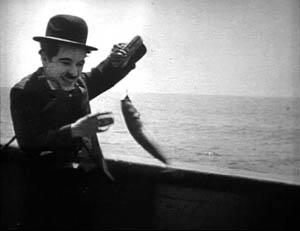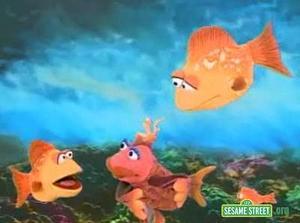Results 451 to 475 of 3085
Thread: The Fish Thread
-
29-08-2011, 10:27 AM #451
-
29-08-2011, 12:30 PM #452
The first pets I ever had were two goldfish, called Bill and Ben, when i was about four. They died from over feeding. Every time someone, not me, walked past their bowl they threw in some fish food. Supposedly, at the end, they were swimming around in soup.
I then graduated to a cat when i was six. Who, until I was 25, I thought was a he when in fact he was a she....
I think my family is strange..
-
29-08-2011, 06:12 PM #453
-
29-08-2011, 06:38 PM #454
-
30-08-2011, 12:42 AM #455
-
30-08-2011, 06:12 AM #456
Another scene from The Codfather

-
30-08-2011, 06:33 AM #457
-
30-08-2011, 07:11 AM #458

"I tell you, it was THIS big"
-
30-08-2011, 08:25 AM #459
-
30-08-2011, 08:27 AM #460
-
30-08-2011, 08:30 AM #461
-
30-08-2011, 08:47 AM #462or TizYou?
































- Join Date
- Mar 2007
- Last Online
- Yesterday @ 10:24 PM
- Location
- Oriental Mindoro, Philippines
- Posts
- 6,562

-
30-08-2011, 09:22 AM #463
^
A real beauty.
The girl looks nice too.
-
30-08-2011, 11:18 AM #464
Fish-catching trick may be spreading among dolphins
 By Elaine Lies | Reuters
By Elaine Lies | Reuters
PERTH, Australia (Reuters) - Dolphins in one western Australian population have been observed holding a large conch shell in their beaks and using it to shake a fish into their mouths -- and the behavior may be spreading.
Researchers from Murdoch University in Perth were not quite sure what they were seeing when they first photographed the activity, in 2007, in which dolphins would shake conch shells at the surface of the ocean.
"It's a fleeting glimpse -- you look at it and think, that's kind of weird," said Simon Allen, a researcher at the university's Cetacean Research Unit.
"Maybe they're playing, maybe they're socializing, maybe males are presenting a gift to a female or something like that, maybe the animals are actually eating the animal inside."
But researchers were more intrigued when they studied the photos and found the back of a fish hanging out of the shell, realizing that the shaking drained the water out of the shells and caused the fish that was sheltering inside to fall into the dolphins' mouths.
A search through records for dolphins in the eastern part of Shark Bay, a population that has been studied for nearly 30 years, found roughly half a dozen sightings of similar behavior over some two decades.
Then researchers saw it at least seven times during the four-month research period starting this May, Allen said.
"There's a possibility here -- and it's speculation at this stage -- that this sort of change from seeing it six or seven times in 21 years to seeing it six or seven times in three months gives us that tantalizing possibility that it might be spreading before our very eyes," he added.
"It's too early to say definitively yet, but we'll be watching very closely over the next couple of field seasons."
The Shark Bay dolphin population is already unusual for having developed two foraging techniques, one of which involves the dolphin briefly beaching itself to grab fish after driving them up onto the shore.
The other is "sponging" -- in which the dolphins break off a conical bit of sponge and fit it over their heads like a cap, shielding them as they forage for food on the sea floor.
But both of these spread "vertically," mainly through the female dolphin population, from mother to daughter. The intriguing thing about this new behavior with the conch shells is that it might be spreading "horizontally," Allen said.
"If it spreads horizontally, then we would expect to see it more often and we'd expect to see it between 'friends'," he added, noting that dolphins are known for having preferences in terms of companions and whom they spend time with.
"Most of the sightings from this year are in the same habitat where we first saw it in 2007, and a couple of the individuals this year are known to associate with the ones that we saw doing it a year or two ago."
The next step would be not only to observe the behavior again in another season but also to try and gather evidence Of deliberate actions on the part of the dolphins.
"If we could put some shells in a row or put them facing down or something like that and then come back the next day, if we don't actually see them do it but find evidence that they've turned the shell over or make it into an appealing refuge for a fish, then that implies significant forward planning on the dolphins' parts," Allen said.
"The nice idea is that there is this intriguing possibility that they might manipulate the object beforehand. Then that might change using the shell as just a convenient object into actual tool use," he added.I see fish. They are everywhere. They don't know they are fish.
-
30-08-2011, 01:51 PM #465
Meanwhile, elsewhere on Teakdoor:
https://teakdoor.com/thailands-zoos-a...head-fish.html (Northern Snakehead Fish)
It seems DD is closet fish admirer..

Northern Snakehead Fish
Distinguishing features of the northern snakehead include a long dorsal fin with 49-50 rays, anal fin with 31-32 rays, small anteriorly-depressed head, eye above the middle part of the upper jaw, large mouth extending well beyond the eye, villiform teeth in bands, large canine on the lower jaw and palatines, length up to 40 inches (1.0 m), with one report of 60 inches (1.5m)[1], and weight up to 15 pounds (7 kg). Coloration is a golden tan to pale brown, with dark blotches on the sides and saddle-like blotches across the back. Blotches toward the front tend to separate between top and bottom sections, while rear blotches are more likely to be contiguous. Coloration is nearly the same between juveniles and adults, which is unusual among snakeheads. Coloration is similar to Channa maculata, but can be distinguished by two bar-like marks on the caudal peduncle (where the tail attaches): in Channa maculata, the rear bar is usually complete, with pale bar-like areas before and after, while in Channa argus, the rear bar is irregular and blotched, with no pale areas around it.[1]
The northern snakehead is a freshwater species and cannot tolerate salinity in excess of ten parts per thousand (Courtenay and Williams 2004). The northern snakehead is an obligate air breather; it utilizes a suprabranchial organ and a bifurcate ventral aorta that permits aquatic and aerial respiration (Ishimatsu and Itazaw 1981, Graham 1997). This unusual respiratory system allows it to live outside of water for several days, where concern is that it might wriggle its way to other bodies of water or be transported by humans. Note that only young of this species (not adults) may be able to move overland for short distances using wriggling motions (Courtenay and Williams 2004). The preferred habitats of this species are stagnant water with mud substrate and aquatic vegetation, or slow muddy streams; it is primarily piscivorous but is known to eat crustaceans, other invertebrates, and amphibians (Okada 1960). They build spawning nests in aquatic vegetation and females discharge eggs over the nest, which are externally fertilized by males.
Snakehead Fish Website
Steamed Snakehead
In Chaozhou Style
Steps
1) Remove seeds of red pepper, shred, wash pork and shred
2) Shred spring onion, salted vegetable and ginger, chop parsley
3) Wash salted lemon, remove seeds and meat, shred the peels
4) Wash pork and mince, clean snakehead, wipe dry (you can cut it into 2 halves)
5) Place chopped parsley and few shredded spring onion on a flat plate
6) Put snakehead on plate, cover with salted vegetable and salted lemon
7) Put minced pork, shredded red pepper and shredded ginger on and surrounding
8) Steam fish for 10 minutes by high heat until cooked (2 halves fish for 8 minutes)
9) Pour fish sauce into small container, add in sauce and mix well
10) Add in the mixed sauce to fish, sprinkle spring onion on
11) Heat wok with 3 tbsp of oil, add in the surface of fish, serve
Remark
tbsp - table spoon
Salted Vegetable, salted lemon and bean paste can be purchased in any dry-food store...
If you cannot purchase salted vegetable, and use 2 pieces of salted lemon....
If you cannot purchase salted lemon, just use 5 pieces of dry salted plums......
There are 2 optioned recipes :
~ same materials as above, no salted vegetable and lemon
~ some mashed garlic, 2 tbsp of Chaozhou bean paste
~ sauce :
sugar and light soy sauce each 1/2 tbsp
approx. 150ml of chicken stock, some sesame oil and pepper
~ clean and cut fish into 2 halves
~ marinated 30 minutes by 1/2 tbsp of salt and pepper
~ coat some corn flour on the surface of fish
~ heat wok with 3 tbsp of oil, fry fish in low heat
~ dish up fish when fish is fried into golden of both sizes
~ heat wok again with 1 tbsp of oil, add in ginger and garlic
~ add in bean paste, sprinkle some wine, add in sauce
~ add in fried fish when sauce is boiled, cook for 1 minute
~ dish up, sprinkle shredded spring onion and red pepper
~ pour in fish sauce, serve

Cold Serve Snakehead
~ materials : snakehead and bean paste
~ wash snakehead, marinate by salt and pepper for 60 minutes
~ wiped fish by dry cloth, put into a bamboo steam case
~ steamed by high heat for 10-12 minutes until fully cooked
~ let fish cool down ( not to chill ) , serve with bean paste
-
30-08-2011, 11:30 PM #466
-
31-08-2011, 01:52 AM #467Thailand Expat
































- Join Date
- Oct 2010
- Last Online
- 31-12-2020 @ 05:03 AM
- Location
- Discombobulated
- Posts
- 2,466

-
31-08-2011, 01:55 AM #468Thailand Expat
































- Join Date
- Oct 2010
- Last Online
- 31-12-2020 @ 05:03 AM
- Location
- Discombobulated
- Posts
- 2,466

-
31-08-2011, 03:57 AM #469
-
31-08-2011, 04:08 AM #470
-
31-08-2011, 04:25 AM #471
-
01-09-2011, 07:15 AM #472or TizYou?
































- Join Date
- Mar 2007
- Last Online
- Yesterday @ 10:24 PM
- Location
- Oriental Mindoro, Philippines
- Posts
- 6,562

-
01-09-2011, 08:21 AM #473
-
01-09-2011, 08:22 AM #474
-
01-09-2011, 08:43 AM #475Member































- Join Date
- Aug 2011
- Last Online
- 05-03-2016 @ 03:27 PM
- Posts
- 592
Most costal waters of the world have been overfished. Must be because man is so smart.
Thread Information
Users Browsing this Thread
There are currently 1 users browsing this thread. (0 members and 1 guests)





 Reply With Quote
Reply With Quote









